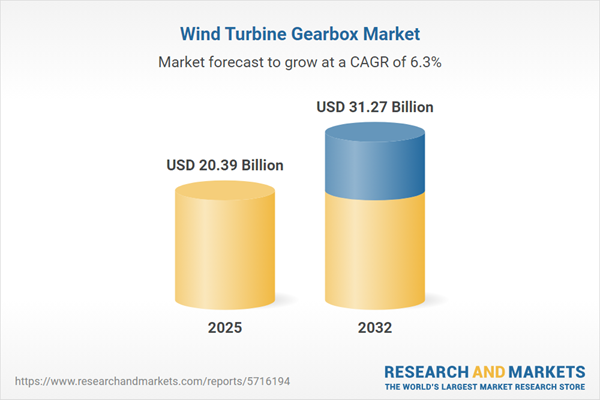Speak directly to the analyst to clarify any post sales queries you may have.
The wind turbine gearbox market is rapidly evolving as industry leaders adapt to new digital strategies, advanced materials, and regional regulations. Senior decision-makers face a landscape that demands intelligent asset management, flexible supply chains, and ongoing operational improvements to secure long-term advantage in renewable energy projects.
Market Snapshot: Wind Turbine Gearbox Market Growth and Opportunity
Currently valued at USD 19.16 billion, the global wind turbine gearbox market is projected to reach USD 20.39 billion by 2025, representing a compound annual growth rate (CAGR) of 6.31%. Growth is driven by investment in wind energy infrastructure as organizations prioritize smarter gearbox systems with digital monitoring, longer lifespans, and more resilient materials. Increasing project scale and complexity have raised the bar for operational reliability, technical support, and risk management as investors look for ways to maximize fleet performance and ensure return on investment across diverse installations.
Scope & Segmentation of the Wind Turbine Gearbox Market
- Type: Single-stage, two-stage, and three-stage gearbox systems support a full range of torque requirements, allowing for maintenance regimes customized to site needs and turbine scale.
- Application: Deployments in offshore environments emphasize corrosion resistance and extended durability, while onshore installations seek accessible servicing and efficiency in routine maintenance operations.
- Power Rating: Distributed wind solutions under 500 kilowatts target smaller, remote applications, while utility-scale gearboxes above two megawatts focus on high-output wind farms and complex grid integration.
- Sales Channel: Original equipment manufacturers (OEMs) provide comprehensive new solutions, while the aftermarket segment offers refurbishment, life extension, and asset risk management services that help operators sustain optimal performance.
- Material: Advanced composites and high-strength steels are increasingly utilized, minimizing drivetrain weight and fatigue while increasing the corrosion resilience essential for long-term service life.
- End User: Independent power producers, utilities, and asset owners require tailored performance metrics, improved reliability, and ongoing efficiency enhancements to support diverse operational business models.
- Regions: The market spans North America, Latin America, Europe, Middle East & Africa, and Asia-Pacific, each with distinct regulatory, supply chain, and technology adoption scenarios that shape product strategies and competitive dynamics locally.
- Top Companies: Major players include ZF Friedrichshafen AG, Moventas Gears Oy, Siemens Energy Flender GmbH, David Brown Gear Systems Limited, SSB Wind Systems A/S, Hansen Transmissions A/S, Nanjing High Accurate Drive Equipment Manufacturing Group Co., Ltd., CSIC Haizhuang Gear Co., Ltd., Elecon Engineering Company Limited, and Dongfang Electric Corporation Gear Manufacturing Co., Ltd.
Key Takeaways for Strategic Decision-Making
- Widespread adoption of digital condition monitoring is transforming maintenance, enabling predictive analytics and early problem identification to minimize disruptions and enhance asset reliability.
- Emerging material science and modular gearbox design are supporting improved service life and flexibility, making rapid project adaptation and scalable solutions more achievable for both onshore and offshore assets.
- Shifts in global and regional supply chains are prompting a move toward localized manufacturing, addressing strict regulatory requirements and reducing exposure to external risks.
- Market differences mean that while some regions prioritize technological integration and rigorous certification, others demand cost-effective, flexible technologies that can scale rapidly for new capacity.
- Comprehensive aftermarket support has become a strategic priority, with OEMs and specialist suppliers focused on helping operators boost asset value and respond swiftly to evolving operational needs and site-specific challenges.
Tariff Impact: Navigating Policy Shifts
Upcoming tariff changes in 2025 are reshaping sourcing and supply chain strategies for wind turbine equipment manufacturers. Organizations are accelerating domestic production and forging new regional partnerships to counter price volatility and regulatory uncertainty. This trend is fostering advances in subassembly kit development and collaborative industry research, particularly in the United States. Early adaptation to these policy shifts strengthens agility and secures greater regional market presence.
Methodology & Data Sources
This analysis is based on a multi-source methodology incorporating executive interviews, technical expert input, targeted survey data, and thorough reviews of current regulatory and technical literature. This approach delivers validated, actionable intelligence for strategic planning in the wind turbine gearbox sector.
Why This Report Matters for Decision Makers
- Enhance strategic planning by leveraging updated monitoring and analytic technologies that improve the reliability and performance of wind energy assets.
- Enable organizations to anticipate and adapt to changing tariffs and regional regulations, resulting in more agile and resilient local supply chains.
- Support informed investment decisions by uncovering new opportunities for regional expansion and technology adoption, strengthening competitive positioning.
Conclusion
Senior leaders gain targeted insights to navigate shifting technology, regulatory, and supply chain landscapes, ensuring organizational resilience and strategic growth in wind energy gearbox operations.
Additional Product Information:
- Purchase of this report includes 1 year online access with quarterly updates.
- This report can be updated on request. Please contact our Customer Experience team using the Ask a Question widget on our website.
Table of Contents
3. Executive Summary
4. Market Overview
7. Cumulative Impact of Artificial Intelligence 2025
List of Figures
Samples

LOADING...
Companies Mentioned
The key companies profiled in this Wind Turbine Gearbox market report include:- ZF Friedrichshafen AG
- Moventas Gears Oy
- Siemens Energy Flender GmbH
- David Brown Gear Systems Limited
- SSB Wind Systems A/S
- Hansen Transmissions A/S
- Nanjing High Accurate Drive Equipment Manufacturing Group Co., Ltd.
- CSIC Haizhuang Gear Co., Ltd.
- Elecon Engineering Company Limited
- Dongfang Electric Corporation Gear Manufacturing Co., Ltd.
Table Information
| Report Attribute | Details |
|---|---|
| No. of Pages | 185 |
| Published | October 2025 |
| Forecast Period | 2025 - 2032 |
| Estimated Market Value ( USD | $ 20.39 Billion |
| Forecasted Market Value ( USD | $ 31.27 Billion |
| Compound Annual Growth Rate | 6.3% |
| Regions Covered | Global |
| No. of Companies Mentioned | 11 |









